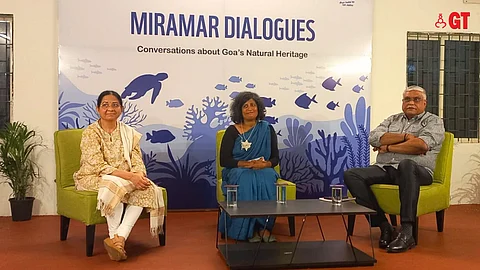

When we think of infrastructure, we typically envision flyovers and multi-lane highways, which have come to symbolise the modern world. However, even our indigenous communities had infrastructure – and it was in tune with nature and had its own system.
The best example of this is Goa’s khazan system. This system, and various threats to it, was the subject of the second session of Miramar Dialogues, titled ‘The Priceless Legacy of Goa’s Khazans’ which was organised by WWF-INDIA Goa State Office, Panjim, recently.
BEHIND THE SYSTEM
One of the speakers at the event was the Director of the Centre for Environment and Natural Resource Management (CENRM), Sangeeta Sonak, who has written books on the khazans, and has also done extensive research on them.
In her presentation, she spoke about the nature of the khazan system and how it helps farmers and fishermen.
She informed that her research, conducted around 25 years ago, aimed to document this indigenous knowledge system, which she described as an ecosystem in itself, providing a home to various marine species, insects and more.
Sandeep Nadkarni, who authored the book, Khazans of Goa, and is a former chief engineer of the Water Resources Department (WRD), maintained that the whole fabric of the khazan system is disturbed due to the change in its management.
He said that it was first managed by the Gaukari system and the Comunidades during the Portuguese rule, and then, by the tenants association post-Liberation.
He added that in the past, farmers knew about khavte (breaking of bunds) by the mere sound, and thus they were repaired in time. But now, that is not the case as there is no common ownership.
Nadkarni informed that during the regime of former Goa CM, Manohar Parrikar, the State government had considered having a co-operative system instead of a tenants association by passing legislation.
He added that in the past, farmers knew about khavte (breaking of bunds) by the mere sound, and thus they were repaired in time. But now, that is not the case as there is no common ownership.
However, this did not materialise since Parrikar had to relocate to Delhi in his new posting in the Union Government.
Nadkarni also pointed out that the farmers who maintained this system had knowledge about the sea, civil engineering, soil mechanics, agriculture, etc., and stated that we are now losing that knowledge.
IN A STATE OF NEGLECT
Architect and educator, Tallulah D’Silva, who moderated the session, pointed out that khazans are currently subject to pollution, littering, land filling with construction debris, etc. In addition to that, bandhs are now constructed using lateritic soil, which gives rise to a different kind of vegetation.
Nadkarni explained that the ban on the removal of estuarine soil is due to its classification under CRZ-I (Coastal Regulation Zone I). However, using the soil of the khazan is part of the indigenous system.
Nadkarni also pointed out that the farmers who maintained this system had knowledge about the sea, civil engineering, soil mechanics, agriculture, etc., and stated that we are now losing that knowledge.
D’Silva revealed that today, many khazans are disappearing, for example, the Patto area which was once part of the system.
Nadkarni mentioned that approximately 30 to 40 percent of khazans are in a deteriorated state, but efforts to restore them are underway, such as the Merces project funded by NABARD-Goa and implemented by ICAR.
LACK OF DATA
Sonak stated that there was no new data about khazan land in Goa. She informed that the figure of 18,951 hectares is a figure given by JC Almeida in his book in 1967. She added that gaining official data is always a challenge as it should be in the public domain.
During the discussion, it was highlighted that there is a lack of substantial data regarding several ecological aspects of Goa, including its rivers and water bodies.
It was emphasised that having such data for easy access to the public was the need of the hour given the rampant concretisation of Goa which directly impacts our forests, rivers, etc.
Elaborating on khazans, it was highlighted that they hold significant potential to boost the local economy, as there is a growing demand for locally produced rice (Korgut), salt and fish — all key products of the khazan system.